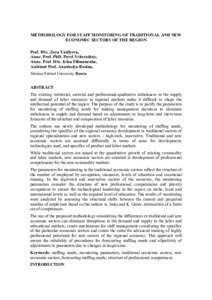Показать сокращенную информацию
METHODOLOGY FOR STAFF MONITORING OF TRADITIONAL AND NEW ECONOMIC SECTORS OF THE REGION
| Автор | Филимоненко, Ирина Владимировна | |
| Автор | Васильева, Зоя Андреевна | |
| Автор | Вчерашний, Павел Михайлович | |
| Автор | Русина, Анастасия Николаевна | |
| Дата внесения | 2019-07-01T07:22:10Z | |
| Дата, когда ресурс стал доступен | 2019-07-01T07:22:10Z | |
| Дата публикации | 2018-10 | |
| Библиографическое описание | Филимоненко, Ирина Владимировна. METHODOLOGY FOR STAFF MONITORING OF TRADITIONAL AND NEW ECONOMIC SECTORS OF THE REGION [Текст] / Ирина Владимировна Филимоненко, Зоя Андреевна Васильева, Павел Михайлович Вчерашний, Анастасия Николаевна Русина // SGEM2017 4th international multidisciplinary scientific conference on social sciences and arts. SGEM: Business and Management. — 2018. — Т. 5. — С. 659-666 | |
| URI (для ссылок/цитирований) | https://sgemworld.at/ssgemlib/spip.php?article4487&lang=en | |
| URI (для ссылок/цитирований) | https://elib.sfu-kras.ru/handle/2311/110576 | |
| Аннотация | The existing territorial, sectoral and professional-qualitative imbalances in the supply and demand of labor resources in regional markets make it difficult to shape the intellectual potential of the region. The purpose of the study is to justify the parameters for monitoring of staffing needs for making management decisions to eliminate imbalances in supply and demand based on adjustments to long-term and short-term forecasts of the structure and composition of labor resources. The authors use newly developed methodology for monitoring of staffing needs, considering the specifics of the regional economy development in traditional sectors of regional specialization and new sectors – high-tech, innovative. Traditional and new economic sectors are assessed differently in terms of aims for development, technologies used, and specifics of product and labor markets. While traditional sectors are aimed at the quantitative growth of existing commodity and labor markets, new economic sectors are oriented at development of professional competencies for the new commodity markets. The parameters for monitoring in the traditional economic sectors reflect the structure of the number of employed by occupation, vacancies, levels of education and vocational training. In the high-tech and innovative sectors of the economy, the monitoring parameters consider the structure of new professional competencies and priority occupations to ensure the technological leadership in the region on niche, local and international levels as well as the required level of education. The results of monitoring were analyzed by assessing the structural shifts between the current and projected number of employees based on the indices A. Salai and K. Gatev; intersection of a finite set of competences. The use of the proposed methodology considering the differences in traditional and new economic sectors can eliminate disruptions in the demand and supply in the labor and educational markets; create mechanisms for staff management considering the specifics of the particular economic sectors and create the order for advanced training of highly professional personnel for new sectors of the regional economy. This approach will ensure the reliability of procedures for forecasting staffing needs and objectivity of adjustments to parameters due to changes in target aims. | |
| Тема | staffing needs | |
| Тема | monitoring parameters | |
| Тема | traditional economic sectors | |
| Тема | new economic sectors | |
| Тема | forecasting staffing needs | |
| Тема | structure of professional competences | |
| Название | METHODOLOGY FOR STAFF MONITORING OF TRADITIONAL AND NEW ECONOMIC SECTORS OF THE REGION | |
| Тип | Journal Article | |
| Тип | Journal Article Preprint | |
| Страницы | 659-666 | |
| ГРНТИ | 06.52 | |
| Дата обновления | 2019-07-01T07:22:10Z | |
| DOI | 10.5593/sgemsocial2017/15 | |
| Институт | Институт управления бизнес-процессами и экономики | |
| Подразделение | Кафедра экономики и управления бизнес-процессами | |
| Журнал | SGEM2017 4th international multidisciplinary scientific conference on social sciences and arts. SGEM | |
| Квартиль журнала в Web of Science | без квартиля |

